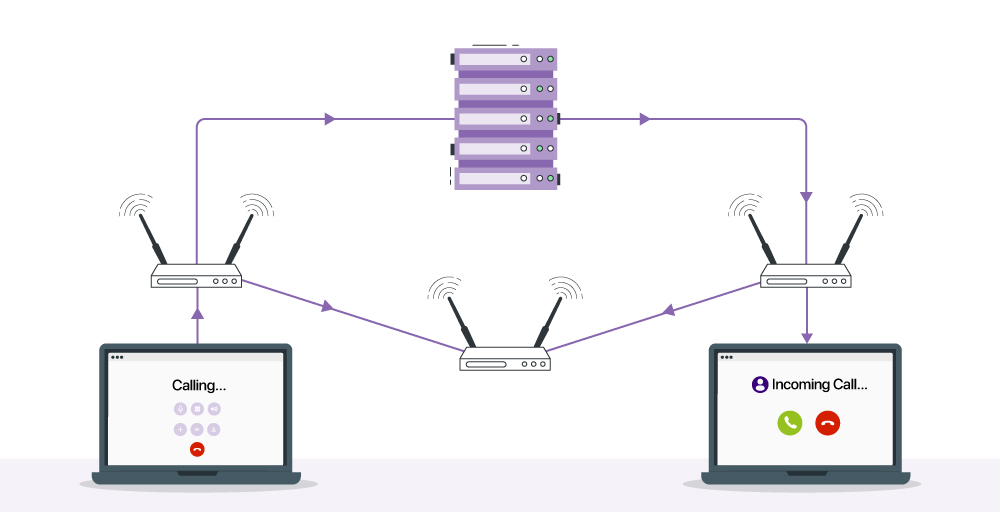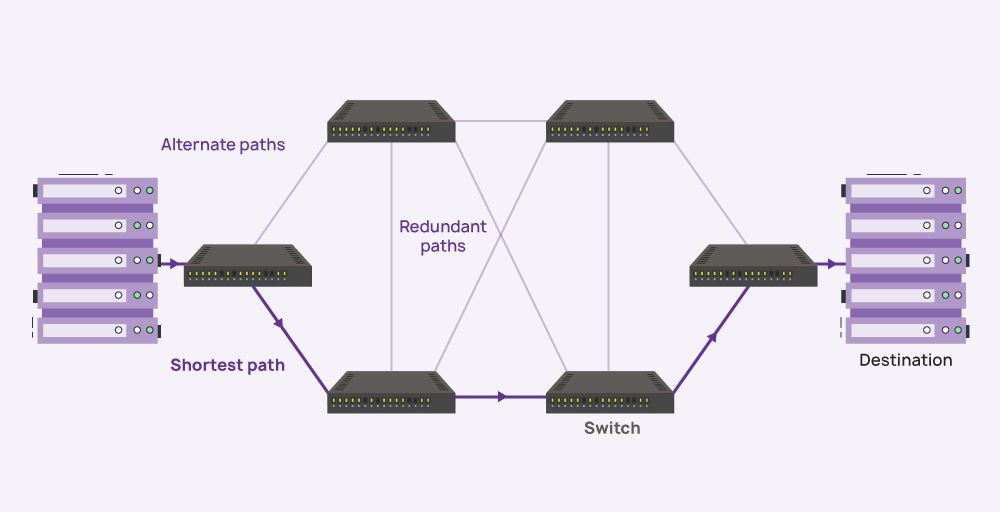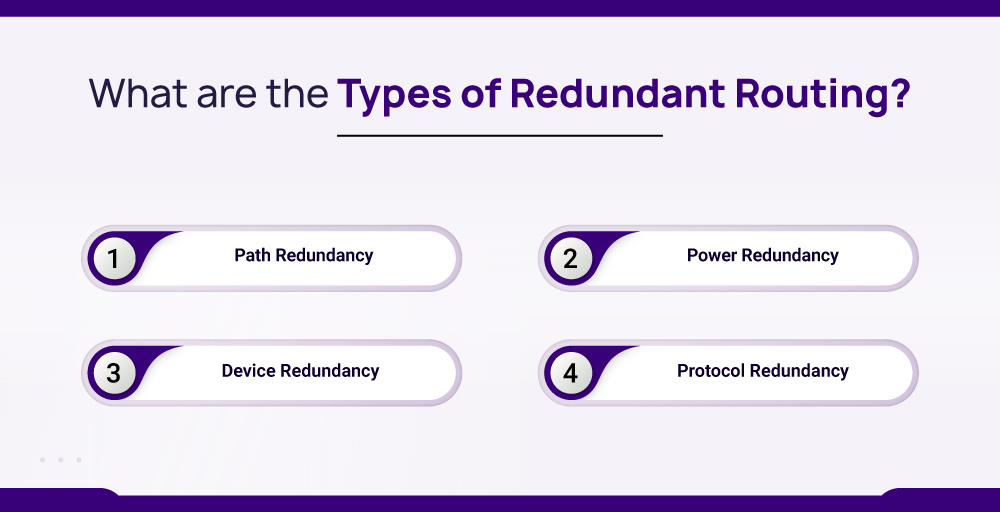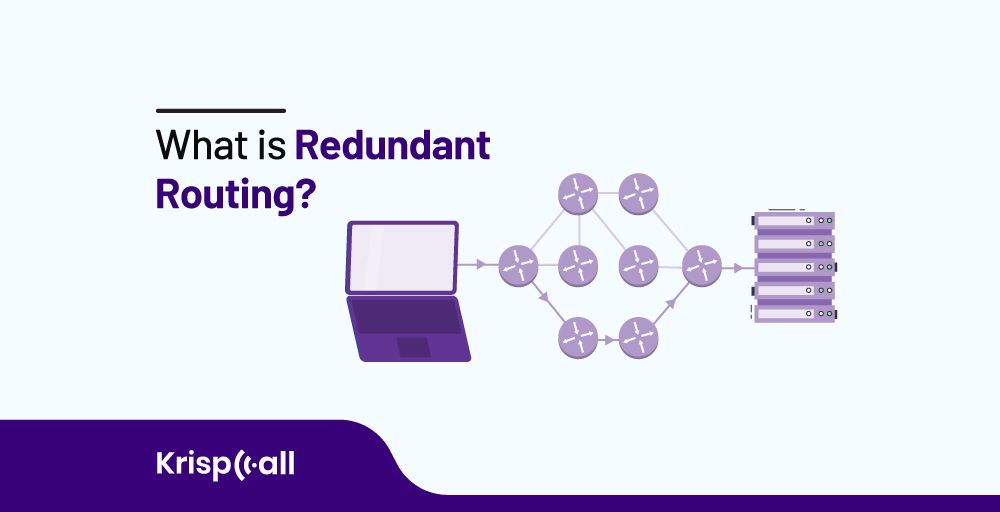Looking for a solution to your network connectivity 📶 issues?
Say hello 👋 to redundant routing – your network’s ultimate safety net.
Whether you’ve experienced the frustration of sudden internet outages or the inconvenience of disrupted online meetings, redundant routing has got your back.
In this blog, we’ll explore redundant routing, discovering how it works its magic to provide uninterrupted connectivity, even during unexpected failures.
So, if you’re ready to bid farewell to network downtime and unlock a seamless networking experience, join us as we unravel the secrets of redundant routing.
Let’s get started! ✨
What is Redundant Routing? 🤔
Redundant routing is a system with multiple links and paths between the caller and the recipient of the call. By rerouting traffic to alternate destinations if the primary fails, it ensures every call connects.

However, complexity is also a threat to reliability. Complex things are harder to understand, more likely to have human error, and more likely to have software bugs 🐝 causing new failure modes. In network design, redundancy and complexity must be balanced.
VoIP service providers use number redundancy management tools that detect network failures and route traffic accordingly. Most providers have redundant servers to manage calls placed over their network.
Redundant Routing is an essential aspect of ☁️ cloud phone systems and 🏢 call centers, and it plays a crucial role in improving customer experience, agent productivity, and overall workflow efficiency. Some benefits of call routing include:
- Reduced waiting times: Call routing minimizes waiting time by automatically assigning calls to the best-fit agents, ensuring that customers do not have to wait in queues.
- Faster resolution: By directing specific calls to the most suitable agents, call routing can help resolve customer issues more quickly and efficiently.
- Optimized workflow: Call routing can help balance the workload among available agents, preventing agent burnout and improving overall customer service quality.
- Improved customer experience: By connecting callers to qualified agents, call routing can enhance the customer experience and lead to higher satisfaction levels.
- Language-based routing: This feature directs callers to agents who are fluent in their preferred language, which is particularly useful for international businesses.
- No more missed calls: Call routing ensures that important calls are forwarded to the right devices, regardless of the agent’s location, preventing missed calls and improving responsiveness.
How does Redundant Routing Work? 🤷
Many businesses 💼 use call routing technology to effectively direct and distribute all calls to teams and locations. But what happens when your main office doesn’t answer due to high call volumes, system outages, or a crisis?

Once a call fails to connect to your initial destination, redundant routing redirects the call to another phone line or 📍location based on your preset rules.
Most failover forwarding services also allow you to select the amount of time the call rings at each location and the ringing strategy (random, sequential, or simultaneous).
If, for some reason, none of your backup destinations connect, you can loop the forwarding sequence to try each location again or simply route calls to your voicemail.
With every alternate call pathway you add, you increase your phone system’s geo-redundancy and the overall reliability of your business communication.
What are the types of redundant Routing? 🙆

1. Path Redundancy
When information is sent from one location to another or when employees and customers access information remotely, redundancy is critical to maintaining network performance. You don’t want to lose full functionality if your Wi-Fi connection fails or a hardware issue arises. Real-time alternate routes should always be available.
The redundancy of pathways can be compared to a city map. Well-planned cities will have alternate routes mapped out if road construction blocks access to a thoroughfare.
A strong network provider can failover to multiple paths in and out of cities and across different carriers without end users even knowing.
2. Power Redundancy
What would happen if your power went out? Could a freak blackout or nasty thunderstorm knock out most of your infrastructure? In the event of a power outage, power redundancy allows you to continue with business as usual.
A backup generator, battery backup, alternate power supply unit, or presence on multiple power grids can all be used as power redundancy. When you invest in power redundancy, you avoid losing money, time, and trust to your customers in the future.
3. Device Redundancy
Device redundancy involves having backup systems or devices in place in case primary devices fail or require maintenance. RAID (Redundant Array of Independent Disks) configurations for storage devices and redundant network paths for networking equipment can achieve redundancy.
In order to maximize the system’s availability and performance, device failures must be minimized. Downtime can have significant financial or operational consequences in mission-critical systems.
4. Protocol Redundancy
Protocol redundancy is the use of multiple protocols to ensure that data can continue to flow even in the event of a network failure or disruption. When one node fails, redundancy protocols automatically reroute traffic to minimize downtime.
There are various redundancy protocols available, each serving a specific purpose and operating at different layers of the OSI model. Some common protocols include:
- First-hop redundancy protocols (FHRP): These protocols allow backup routers to take over when the default gateway fails, usually within a few seconds. Examples of FHRP include Hot Standby Router Protocol (HSRP), Virtual Router Redundancy Protocol (VRRP), and Common Address Redundancy Protocol (CARP).
- Layer 2 redundancy protocols: These protocols ensure the continuity of all VLANs in the network, even if a link or node fails. Examples include the Spanning Tree Protocol (STP)
- Layer 3 redundancy protocols: These protocols ensure that there is a default gateway on each network segment, even if the primary router fails. Examples include Gateway Load Balancing Protocol (GLBP)
Which VoIP cloud phones offer built-in redundancy for reliable calls?
Several cloud phones offer built-in redundancy for reliable calls. Some of the best are are:
1. Sonictel
The first we have on the list is Sonictel. With its Internet Backup, Sonictel provides VoIP redundancy. It helps smooth communications by seamlessly switching to the Enterprise 4G/5G LTE Cellular Data service during outages. It also includes geographical redundancy across the United States, providing easy failover and disaster recovery capabilities.

Features
- Automated attendant
- Voicemail to email
- 3-Way Calling
- Conference call.
- Auto Attendant
- Blocked Caller Id
Pricing
Contact Sonictel Customer Support
2. RingCentral
RingCentral delivers reliable VoIP services by widely dispersing data centers. If one goes down, the other takes over effortlessly. Their distributed architecture splits workloads between servers and centers, enhancing performance as well as fault tolerance.

The aim of this setup is to maintain consistent call quality, something vital for companies using VoIP.
Features
- Essential business analytics for IT professionals.
- Unlimited enterprise-grade HD video, whiteboards, and messaging.
- Advanced call monitoring and handling.
- Access to Google, Microsoft, and other APIs.
Pricing
- Core: $30 per user per month
- Advanced: $35 per user per month
- Ultra: $45 per user per month
3. 8×8
8×8 provides stable VoIP services through the use of redundant data centers and network infrastructure. This includes servers, networks, equipment for alternate communications channeling, etc., in order to create backup systems so that if a failure occurs within one system, it will switch over automatically onto another channel at any moment (termed high availability), which can be upwards of ten seconds between switching channels normally.

Their platform implements these features on one screen, providing failover for hardware and routes. Depending on the situation, backup resources are automatically switched to, or you can manually select which resource must remain active for communication between A and B to be successful.
With its user-friendly operations and fault-tolerant redundancy architecture, 8×8 aims to offer users reliable VoIP services.
Features
- Business Phone System and SMS:
- Video Conferencing
- Team Chat and Collaboration:
- Analytics:
- Contact Center Features:
- Supervisor analytics
Pricing
X2: $24 per user per month (paid annually) or $28 per user per month (paid monthly),
4. Nextiva
Nextiva’s VoIP platform features redundant servers and network infrastructure, providing backup systems and paths to ensure continuous service availability. Nextiva’s VoIP solution offers redundant servers and network infrastructure.

Features
- HD VoIP phone service
- Unlimited business text messaging
- Team chat app
- VoIP Switchboard
- Voicemail to email messaging
- Team presence/IM
Pricing:
- Essential $18.95 per month,
- Ultimate $57.95 per month.
- Enterprise: Custom
What to Consider while Choosing Redundant Routing?
- Reliability: When a primary route fails, redundant routing provides a backup path. This redundancy ensures that critical services remain accessible even if the network goes down.
- Performance: Implementing redundant routing incorrectly can negatively impact performance. To avoid delays, especially in real-time applications such as voice or video, routing decisions need to be made quickly.
- Cost: Routing redundantly typically requires additional infrastructure and maintenance. An analysis of the cost-benefit of redundancy must be conducted.
- Complexity: Large networks and distributed systems require redundant routing configurations. It is important to plan, configure, and maintain redundant paths so they can function when needed.
- Security: Redundant routing can have implications for network security. To mitigate the risk of unauthorized entry or malicious behavior, it is crucial to implement robust security measures for redundant routes in order to thwart any potential exploitation of additional pathways generated through redundancy.
- Uptime: Redundant networks ensure continuous availability, crucial for organizations providing 24-hour services to customers, patients, or clients.
Conclusion
Redundant routing is one of the most important parts of network infrastructure that keeps data flowing. Network health and uptime can be protected by redundant routing protocols. A redundant approach prevents failures or outages that might occur on the route due to human error, software glitches, or other problems.
Besides furnishing a bypass route in case of closeness on the primary link, redundant routing also apportions external traffic coming from an outside source for destination B among those multiple routes.
In the future, we will continue to see improvements in routing technology. IoT devices, cloud computing, and high-speed connectivity will require routing technologies to adapt and evolve. Businesses can use these new technologies to better utilize network resources.
So, embrace the power of redundant routing and stay ahead of the curve in this ever-evolving digital era.
FAQ
Is redundant routing secure?
Yes, redundant routing can be considered a secure practice in network infrastructure. Having a redundant network ensures businesses stay connected, minimizes downtime, and isolates impacted components quickly. DDoS attacks can be reduced and security improved by ensuring continuous connectivity and ensuring data integrity.
How does redundant routing affect call quality?
Call quality can be affected both positively and negatively by redundant routing. As well as improving call quality, it can also increase latency and complexity. Redundancy benefits must be properly planned and implemented to avoid potential drawbacks.
Does redundant routing impact my current internet data usage?
The impact of redundant routing on your current internet data usage is generally minimal. In case of failure, redundant routing ensures continuous connectivity. Redundancy may result in slightly increased data usage due to additional network overhead, but most users won’t notice the difference. Improved reliability and uptime often outweigh minor data usage increases.
What are the most common misconceptions about Redundant Routing?
Some common misconceptions about redundant routing include:
- Conflict between redundancy and symmetry: Symmetry and redundancy are not mutually exclusive. Finding the right balance between redundancy and symmetry is critical to network reliability. In network design, redundancy can lead to more unpredictable traffic entry and exit points
- Increased unpredictability: Redundancy is sometimes misunderstood as increasing unpredictability at entry and exit points. Implementing redundant routing can actually improve network reliability and minimize the impact of unforeseen conditions.
- Routing overhead: Some may believe that redundant routing significantly increases routing overhead. Modern routing protocols and network infrastructure reduce routing overhead by handling redundant paths efficiently.
- Network redundancy only for backup: Redundant routing is not just for backup purposes. It also contributes to improved network reliability, security, and performance. By integrating redundant components and paths it can help maintain continuous connectivity, boost system stability, and increase data security





